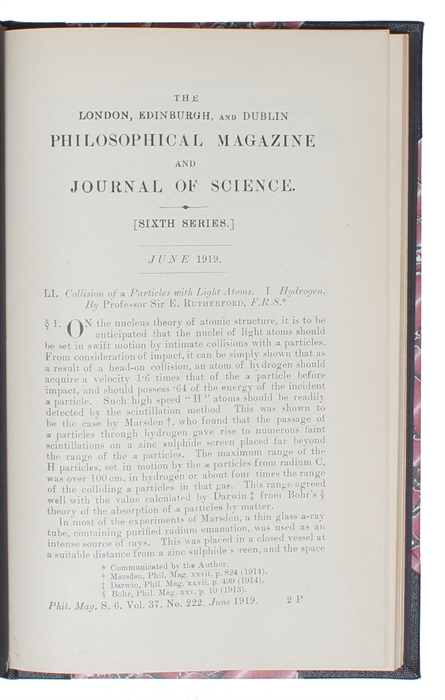SPLITTING THE ATOM - PMM 411
RUTHERFORD, E. (ERNEST).
Collision of alpha Particles with Light Atoms. (4 Parts). I. Hydrogen. II. Velocity of the Hydrogen Atom. III. Nitrogen and Oxygen Atoms. IV. An Anomalous Effect in Nitrogen.
[London, Taylor and Francis, 1919] 8vo . In recent half cloth with cloth title-label with gilt lettering to front board. Extracted from "The London, Edinburgh, and Dublin Philosophical Magazine and Journal of Science" Sixth Series. A fine and clean copy. [Rutherford's paper:] pp. 537-587. [Withbound:] Pp. 537-616.
First appearance of this seminal paper which contains Rutherford's discovery of artificial transmutation. He here discovered, that the atomic nucleus (discovered by him in 1911) itself had a structure, when, by bombarding nitrogen with alpha particles, he produced THE FIRST ARTIFICIAL TRANSFORMATION OF AN ELEMENT INTO ANOTHER, and what was left after the bombardment had to be those of oxygen atoms. - Thus thus began the age of nuclear physics.
"Rutherford was .. the first man ever to change one element into another as a result of the manipulations of his own hands. He had achieved the dream of the alchemists. He had also demonstrated the first man-made "nuclear reaction". By 1924 Rutherford had managed to knock protons out of the nuclei of most of the lighter elements." (Asimov).
"A few years before, Marsden had noticed scintillations on a screen placed far beyond the range of alpha particles when these particles were allowed to bombard hydrogen. Rutherford repeated the experiment and showed that the scintillations were caused by hydrogen nuclei or protons. This was easily understood, but when he substituted nitrogen for the hydrogen, he saw the same proton flashes. The explanation he gave in 1919 stands beside the transformation theory of radioactivity and the nuclear atom as one of Rutherford’s most important discoveries. This, he said, was a case of artificial disintegration of an element. Unstable, or radioactive, atoms disintegrated spontaneously; but here a stable nucleus was disrupted by the alpha particle, and a proton was one of the pieces broken off." (DSB).
PMM 411.
Order-nr.: 57199

